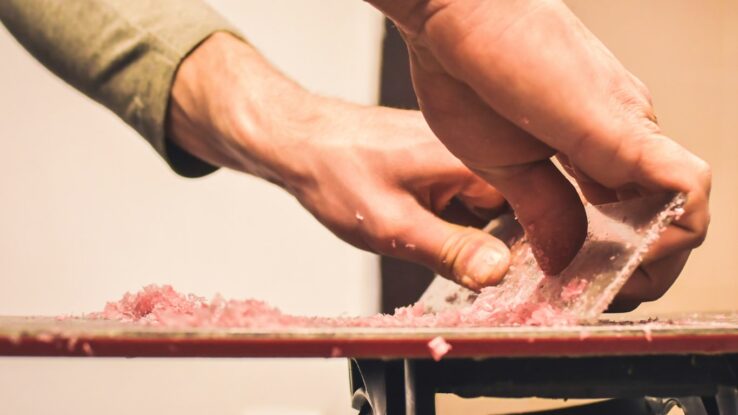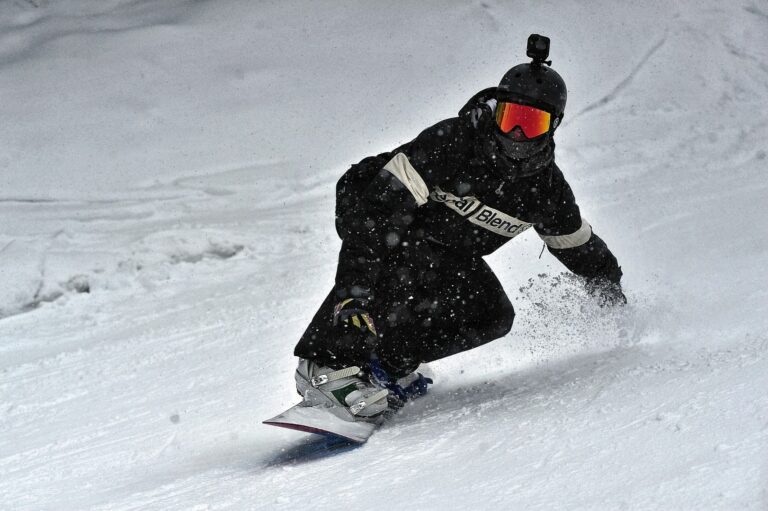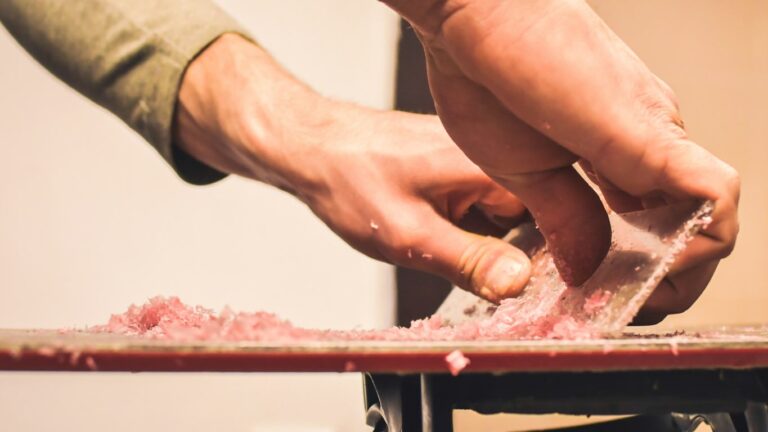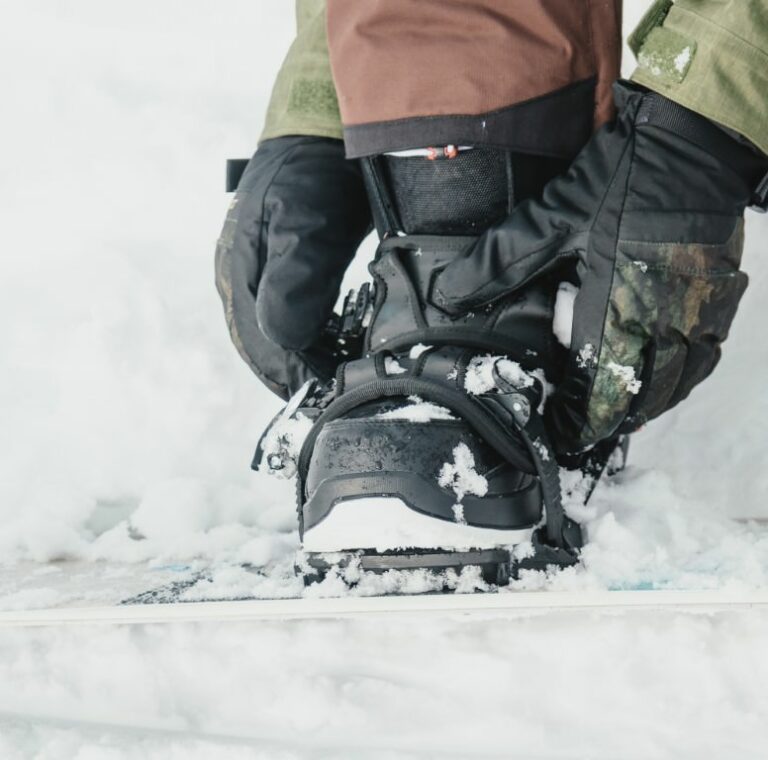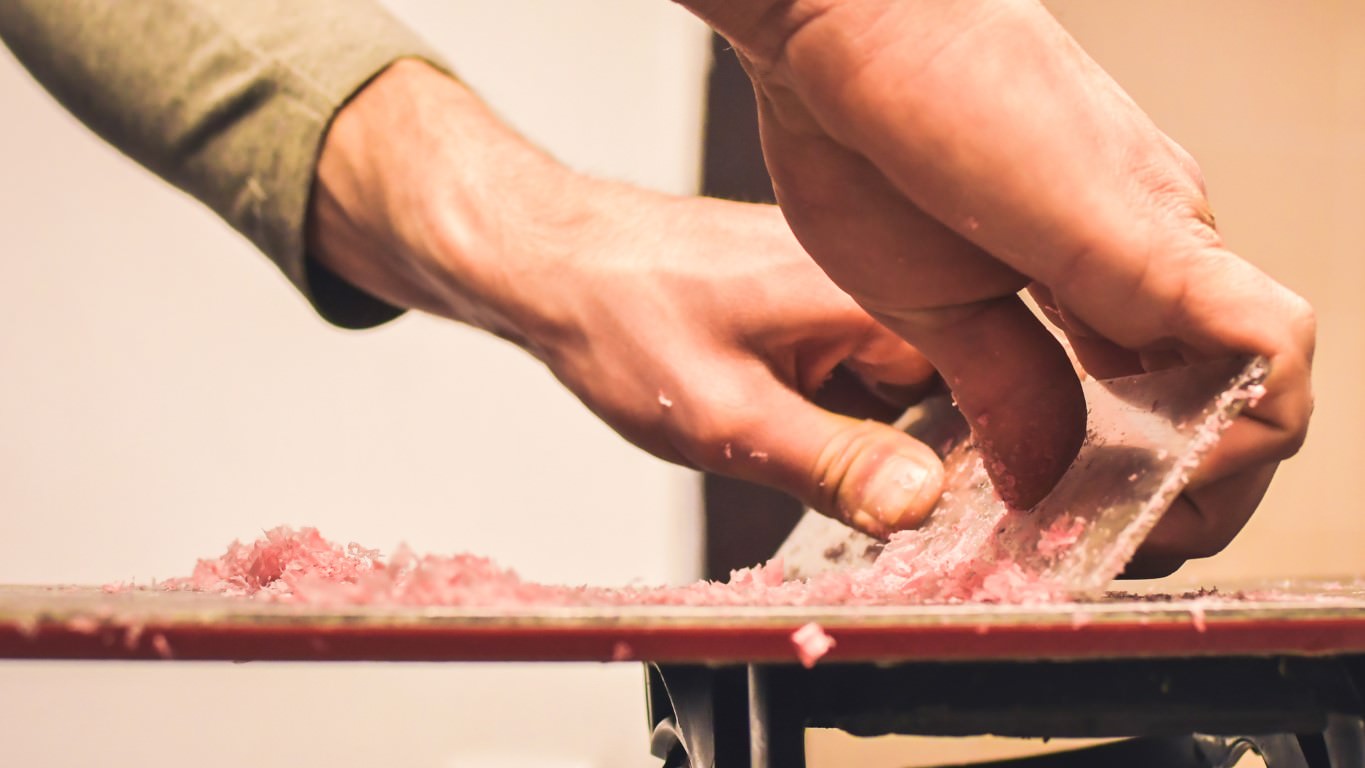The Inherent Risks: Is Snowboarding Dangerous?
Snowboarding, like all extreme sports, comes with associated risks. Statistics from the National Ski Areas Association reveal a notable disparity: while snowboarders make up around 25% of ski area visitors, they account for approximately 50% of injuries.
However, risks aren’t uniformly distributed and can fluctuate based on skill level, chosen terrain, and weather conditions. Understanding these risks and adopting the right precautions can significantly diminish the chance of accidents resulting in injury or death.
But while there are risks, it is important to note the overall risk is still just four injuries per 1000 days of snowboarding. And according to Snowbrains, the risk of dying is just 1 in 2.2 million. This is significantly lower than sports such as horse riding, mountaineering and kayaking. Even running/jogging is riskier, with around a 1 in a million chance of dying.
Common Snowboarding Injuries
I have been snowboarding for more than 20 years. In that time, two friends broke their wrists while I was with them; one also broke an ankle, and another got a minor concussion. I personally have pulled a calf muscle, separated my collarbone from my clavicle and cracked a rib. Only the leg stopped me riding and I have luckily never had to use the emergency services.
But not everyone is so lucky. Below are the most frequently reported snowboarding injuries in order of frequency:
- Wrist: As a natural reflex, snowboarders tend to outstretch their hands when falling, leading to wrist injuries. This is more common with beginners as they fall more often and have yet to learn how to fall.
- Ankle: A lot of force is applied through the ankle when snowboarding. Your boot is big, bulky and fairly stiff to cope with this. But if your boots are too loose, or you have a very big impact you can still sprain or break an ankle.
- Knee injuries: Snowboarders sustain fewer knee injuries due to twisting falls than skiers, but direct impacts are more common. Twisting injuries mainly occur when you only have one foot strapped in.
- Head injuries: Catching an edge and being catapulted forwards or backwards onto your head is a horrible way to crash. This commonly leads to concussions, most of which can be prevented by a helmet. Other head injuries are usually due to high speed crashes into trees, rocks, posts or people.
- Shoulder: Dislocation can occur during a fall when the arm is outstretched out and you fall on it. A direct impact to the shoulder can do the same, or break a collarbone. Although, in my case, I was lucky and just tore the small muscle between the collarbone and the clavicle.
- Trunk: Your chest, abdomen, pelvis, and back can all be at risk from impact injuries – I cracked a rib on a rail. Likewise, you can over extend your back during a scorpion crash when your torso hits and then your board carries on over your head.
Snowboarding vs. Skiing: A Comparative Danger Assessment
Stats seem to show that snowboarders are around 50% more likely to get injured than skiers as techniques can be harder to master. But according to the Guardian, snowboarders are 30% less likely to die on the slopes than skiers.
The increased injuries are partly because beginner snowboarders pick up a lot more injuries than first time skiers. Also, snowboarders typically use the mountains more playfully than skiers, getting involved in freestyle and taking more risks, which leads to more injuries.
Some studies seem to show skiers are more likely to be involved in bad injuries often related to high speed crashes. Furthermore, ski touring in the backcountry accounts for most avalanche deaths, which skews the fatality figure.
The debate on whether snowboarding or skiing poses more danger is ongoing. However, instead of focusing on which sport is more dangerous, the emphasis should be on ways to use the slopes safely.
How to Prevent Injuries
The best way to prevent injury would be to stay home and watch videos of other people snowboarding. But that would be no fun! The following all help snowboarders avoid injury:
- Know your limits: Don’t run before you can walk, know what you can do and only push for improvement in small increments.
- Check your gear: Damaged gear, loose screws or simply aging equipment can fail. A pro boardercross friend of mine had his career ended when a high back snapped at high speed and he crushed a vertebra.
- Proper equipment use: If your gear is set up incorrectly, you are more likely to fall. Furthermore, you can injure yourself in silly ways if you are not using it correctly.
- Physical conditioning: The fitter you are, the more fun you’ll have and the less chance of injury. Strength and flexibility conditioning prepare your body for the physical demands of snowboarding, as does a little warm up before you start for the day.
- Technique training: Keep learning. Even good snowboarders benefit from technique training. It improves balance, control, and reaction time, all of which decrease the likelihood of falls and subsequent injuries.
- Protective gear: See below
Protective Gear: Your Safety Net on the Slopes
Here’s a list of protective gear to use for snowboarding:
- Helmets: Lid up! A helmet designed for snow sports not only protects your noggin, drastically reducing head injuries, but it also is a good place to put stickers…
- Wrist guards: The least cool bit of snowboarding gear, but one of the most important for stopping the most common injury. They provide support and prevent wrist fractures and sprains. You can buy them built into gloves, so there is no need for anyone to know you’re wearing them.
- Crash pants: These help to protect against bumps and bruises on your hips, thighs and posterior. If you have a prominent coccyx they can be the difference between being able to sit and having to stand…
- Back protector: To stop you over extending your back, or getting impact injuries. Of more use if you go big in the park or off-piste. But also useful for those with pre-existing back issues.
- Knee pads: Starting out can be brutal on your knees, particularly if conditions are icy. Knee pads are also useful as you progress into freestyle, especially doing rails.
- Avalanche gear: If you are riding off-piste and/or backcountry in non-avalanche controlled terrain then you should invest in an avalanche beacon, shovel and probe. Now you’ll need to know how to use them, so get some avalanche training and do plenty of practice rescues.
- Airbag: Again for those venturing away from the managed slopes. An avalanche airbag is activated if you get caught in a slide and can help keep you on the surface and/or help provide an air pocket if buried.
Other Factors that Impact Snowboarding Safety
There is more to consider than just your ability and the gear you are wearing:
Terrain
As we have already alluded to, the terrain you ride massively impacts safety. If you cruise on blues and greens, it is far less risky than hitting double black diamonds or the park. Equally. heading between the piste on slopes below 30 degrees is safer than doing steep couloirs or riding through the trees.
This is all about making good choices. Don’t hit a black for your first run, and avoid the park if you are not yet confident on blue slopes. Ride within your limits until you are warmed up, and then if pushing yourself, do so in as controlled a way as possible.
You should also consider how the terrain is affected by the weather.
Weather
The weather conditions heavily influence snowboarding safety. Bad visibility, icy surfaces, or poor snow cover all make snowboarding more risky. Off-piste lots of fresh snow increases the risk of avalanches or treewell accidents. Equally, poor weather in the wrong clothing can lead to hypothermia or frostbite.
So it’s crucial to check weather forecasts before venturing out. Weather changes quickly in the mountains, having the correct goggles for the conditions helps you to see (and be safer) and wearing the right clothing is more than looking good it could save your life.
Hypothermia is a risk if your core gets too cold, this can happen if you get stuck outside for a long time due to injury or equipment problems. But it also occurs if your inner layers get damp, through sweat or precipitation, and your body begins to cool when you stop exercising. Good baselayers and avoiding cotton next to the skin help keep your core dry and warm.
How Busy the Slopes Are
Other slope users add to the snowboarding risk. Let’s face it if you have the slopes to yourself, or they are very quiet, you can just take the line that feels right to you. It is both safer and more fun. When it’s busy, it can be frustrating and the risk of collisions increases accordingly.
To improve safety reduce your speed and playfulness the busier it is. Resist the urge to go fast or pop tricks when the slopes are rammed. Remember, the uphill slope user is ALWAYS 100% at fault in a collision, so allow enough space to deal with the unexpected. Make yourself aware of the FIS skiers code.
Safety Factors That Snowboarders Are in Control Of
Besides choosing not to snowboard when it is busy, in poor weather, or in more difficult terrain, there are factors you are in control of:
Snowboarding Technique: A Cornerstone of Safety
In theory the better snowboarder you are the less likely you are to fall so the safer you will be. But conversely, the better you are the more likely you will go big in the park or visit more dangerous terrain taking bigger risks.
However, mastery of good snowboarding technique is vital for safety. Understanding how to control your speed, execute sharp turns, stop instantly, and fall safely all significantly reduce injury risks.
This is born out of the fact that beginner snowboarders suffer more injuries than experienced ones. But life changing injuries are more likely to be suffered by experienced snowboarders who get it wrong when going big or in dangerous terrain.
So practice, take lessons, ride with friends that are better than you and ride responsibly.
Responsible Riding: Safe Snowboarding Practices
Being a safe snowboarder extends beyond personal injury avoidance – it’s about being a responsible part of the mountain community. This involves following the rules and regulations of the ski resort, staying in control, refraining from taking unnecessary risks, and maintaining awareness of other slope users.
Now that is all well and good, but part of the fun of snowboarding is taking risks. If you always ride within yourself you won’t improve and you will have less fun. I can attest to this as I did some snowboard photography during a season in Whistler, and riding with a big expensive camera I dialed it down to avoid falling. Snowboarding became less fun, more like a form of transport.
So, the answer is finding the right balance. Take risks at the right time, which is when you cannot hurt anyone else and the risk to yourself is at its lowest. Assessing this is about knowing your body, the conditions, your ability and being aware of others. This is why riding while inebriated is not a smart idea (although it is fun).
Assessing a Ski Resort or Terrain Park’s Safety
This is not usually something to worry about. Major ski resorts in traditional alpine countries are all as safe as each other. However, safety standards do vary across countries, for example, some chair lifts in the US don’t have safety bars, and the off-piste in Europe is not avalanche controlled like the in-bounds areas in North America.
But safety may be reduced if you are at a small resort or in less developed countries. For example, I was in Macedonia a few years ago and piste markings were rather lacking as was slope grooming.
Things to consider at ski resorts:
- The quality and regularity of slope maintenance.
- Whether in-bound off-piste is avalanche controlled.
- Are trails and hazard warnings well marked?
- The availability of professional ski patrol or emergency services.
- Are ski lifts new and/or well maintained and do they have safety bars?
FAQs about Snowboard Safety
How can I prepare physically to reduce the risk of injury while snowboarding?
Physical preparedness is key in minimizing snowboarding injuries. Here’s how you can prepare:
- Strength training: Focus on core, lower body, shoulder and wrist strengthening exercises.
- Balance exercises: Improve your balance through yoga or pilates.
- Cardiovascular fitness: Engage in aerobic activities like running or cycling to improve your stamina.
- Flexibility exercises: Regular stretching or yoga can improve your flexibility to help prevent muscle strains.
Are certain snowboarding styles or disciplines more dangerous than others?
Yes, freestyle or backcountry/off-piste snowboarding is riskier due to unpredictable terrain, higher speeds, more obstacles or more complex maneuvers. Risks can be managed but the faster, bigger, higher, steeper etc, the more dangerous it is and the bigger the consequences.
How can I stay safe while snowboarding in the backcountry or off-piste?
Avalanche risks, changing snow conditions, and potential isolation add to the danger. To enhance safety:
- Never ride off-piste alone.
- Use appropriate equipment, such as an avalanche beacon, shovel, probe and possibly an avalanche airbag.
- Make sure all of your crew have avalanche safety/rescue training.
- Always check the local avalanche forecast before heading out.
- Hire a guide.
- Don’t blindly follow tracks.
- Trust your instincts – if something feels sketchy, don’t do it.
What steps can I take to reduce the risk of collision with other snowboarders or skiers?
To avoid collisions:
- Maintain a safe distance from others, particularly in crowded areas.
- Stay alert and adjust your riding to the flow of traffic on the slopes.
- Respect the right of way—those that are downslope have it.
- If doing something unexpected, check behind you first.
Conclusion
Snowboarding comes with inherent risks. Understanding these dangers and taking the appropriate precautions significantly reduces the risk. So equip yourself with the right gear, listen to your body, stay alert, and respect the rules and other riders on the slopes. Remember, the goal isn’t just to maintain the enjoyment at this very moment, but also for the rest of your snowboarding years to come.



